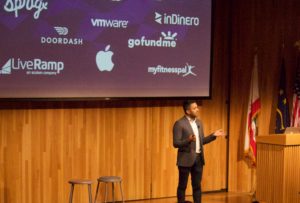This week of the Newton Lecture Series brought yet another example of diversity in entrepreneurship. Amit Kumar joined students on Tuesday to discuss his path from an Electrical Engineering and Computer Science Major at Berkeley to an entrepreneur to a venture capitalist—all while maintaining his optimism and good humor. Victoria Howell, who helps organize speakers for the series, introduced him as a connector. “He loves connecting people,” she stated, “And you can see that in his passion.”
Background and Education:
Amit Kumar began by sharing how excited and humbled he was to stand on a platform previously shared by an incredible lineage of speakers. When talking about his background at Berkeley, he admitted that it used to be a different place; one where entrepreneurship wasn’t accessible, and there were fewer successful figures to look to for guidance. He contrasted this to the current state of Berkeley as one of the leading producers of some of the most significant and productive companies in the world.
Kumar’s tenure at Berkeley was eclectic, and his resume included the ASUC Senate, a Cal Cricket team, and the Indus Cultural Show. He graduated after only three years with an EECS major, and shared some of the insights he gained from the university. Kumar believes that students at Berkeley are privileged to be part of an ecosystem replete with opportunities, incredible professors, and the chance to learn self-reliance. Another principle he shared: take internships seriously, as top companies view internships as the best possible recruiting channel for new talent.
After graduating, Kumar t ook a job at Microsoft—the most established company at the time. There, he learned how to be a great engineer, which he distinguished from being a great student. Kumar found that being young was an advantage: he could outwork everyone he was surrounded by, and he quickly became the company’s leading software design engineer. Kumar admits that starting at a large company is underrated, especially compared to shiny visions of CEO-status at startup companies. At Microsoft, he learned how to be a professional, and got to invest in relationships with like-minded and motivated individuals. He further advised his student-audience to join companies that are growing, and to work at headquarters, where there are fewer caps on what you can accomplish.
ook a job at Microsoft—the most established company at the time. There, he learned how to be a great engineer, which he distinguished from being a great student. Kumar found that being young was an advantage: he could outwork everyone he was surrounded by, and he quickly became the company’s leading software design engineer. Kumar admits that starting at a large company is underrated, especially compared to shiny visions of CEO-status at startup companies. At Microsoft, he learned how to be a professional, and got to invest in relationships with like-minded and motivated individuals. He further advised his student-audience to join companies that are growing, and to work at headquarters, where there are fewer caps on what you can accomplish.
Three companies, Two Failures:
The Venture Capitalist humbly admits that his own narrative is about becoming, in his words, “Progressively less of a failure.” Kumar endured the failure of two projects he co-founded. The first project failed because of a lack of dedication from both himself and his partner. They sold the company, but Kumar maintains that he gained valuable insights from this experience. He advised future entrepreneurs to make sure they share the same vision and goals as their partners. Without this cohesion, a successful company is nearly impossible. Furthermore, he encouraged the students to be open about their ideas, shattering the myth that others in the industry are constantly scouting for ideas to steal. “No one is going to drop their job and steal your idea,” he stated.
Kumar’s second company, an online gambling social network, again failed. Kumar wanted to utilize trends of user-generated content with social networking capacities, and initially had success raising money and building a great team. Despite this, the content of the app wasn’t enough to generate interest. Kumar explained, “The product was too complicated for simple gamblers and too simple for sophisticated gamblers.” His takeaway? Again, impossibly positive. Kumar vowe d to dream big, to work with competent people, and to better understand his customer. His most important bit of knowledge from this experience was that fundraising was not only important, but absolutely vital to a company, like breathing is for life.
d to dream big, to work with competent people, and to better understand his customer. His most important bit of knowledge from this experience was that fundraising was not only important, but absolutely vital to a company, like breathing is for life.
Cardspring was Kumar’s greatest success, and served as an antidote to the failure he had felt earlier in his career as an entrepreneur. Cardspring, an Application Program Interface (API) that allows developers to create applications for credit and debit cards, applied the skills and understanding Kumar’s previous companies had afforded through their lack of success. Kumar realized he wanted to build something that he himself could use, that incorporated current trends, and had a highly leveraged network. The result was a partnership with Twitter, in which Kumar felt the two companies had promising vision alignment and potential for large-scale success.
A Venture Capitalist Is Born:
After Cardspring was acquired by Twitter, Kumar was approached by a venture capitalist about a position at Accel. To the surprise of many students in the room, Kumar admitted not knowing if he’d be good at the job. Kumar, however, knew his strength was in creating relationships. To reassure himself that he was capable of the job, he sought mentorships, invested his own money, and joined as an early stage partner in May 2016. Kumar concluded his presentation by reiterating the importance of being flexible, proactive, confident, and “Learning how to learn.” Kumar’s story of success through repeated failure and resilience is one that was both refreshing and encouraging.
This week of the Newton Lecture Series brought yet another example of diversity in entrepreneurship. Amit Kumar joined students on Tuesday to discuss his path from an Electrical Engineering and Computer Science Major at Berkeley to an entrepreneur to a venture capitalist—all while maintaining his optimism and good humor. Victoria Howell, who helps organize speakers for the series, introduced him as a connector. “He loves connecting people,” she stated, “And you can see that in his passion.”
Background and Education:
Amit Kumar began by sharing how excited and humbled he was to stand on a platform previously shared by an incredible lineage of speakers. When talking about his background at Berkeley, he admitted that it used to be a different place; one where entrepreneurship wasn’t accessible, and there were fewer successful figures to look to for guidance. He contrasted this to the current state of Berkeley as one of the leading producers of some of the most significant and productive companies in the world.
Kumar’s tenure at Berkeley was eclectic, and his resume included the ASUC Senate, a Cal Cricket team, and the Indus Cultural Show. He graduated after only three years with an EECS major, and shared some of the insights he gained from the university. Kumar believes that students at Berkeley are privileged to be part of an ecosystem replete with opportunities, incredible professors, and the chance to learn self-reliance. Another principle he shared: take internships seriously, as top companies view internships as the best possible recruiting channel for new talent.
After graduating, Kumar t ook a job at Microsoft—the most established company at the time. There, he learned how to be a great engineer, which he distinguished from being a great student. Kumar found that being young was an advantage: he could outwork everyone he was surrounded by, and he quickly became the company’s leading software design engineer. Kumar admits that starting at a large company is underrated, especially compared to shiny visions of CEO-status at startup companies. At Microsoft, he learned how to be a professional, and got to invest in relationships with like-minded and motivated individuals. He further advised his student-audience to join companies that are growing, and to work at headquarters, where there are fewer caps on what you can accomplish.
ook a job at Microsoft—the most established company at the time. There, he learned how to be a great engineer, which he distinguished from being a great student. Kumar found that being young was an advantage: he could outwork everyone he was surrounded by, and he quickly became the company’s leading software design engineer. Kumar admits that starting at a large company is underrated, especially compared to shiny visions of CEO-status at startup companies. At Microsoft, he learned how to be a professional, and got to invest in relationships with like-minded and motivated individuals. He further advised his student-audience to join companies that are growing, and to work at headquarters, where there are fewer caps on what you can accomplish.
Three companies, Two Failures:
The Venture Capitalist humbly admits that his own narrative is about becoming, in his words, “Progressively less of a failure.” Kumar endured the failure of two projects he co-founded. The first project failed because of a lack of dedication from both himself and his partner. They sold the company, but Kumar maintains that he gained valuable insights from this experience. He advised future entrepreneurs to make sure they share the same vision and goals as their partners. Without this cohesion, a successful company is nearly impossible. Furthermore, he encouraged the students to be open about their ideas, shattering the myth that others in the industry are constantly scouting for ideas to steal. “No one is going to drop their job and steal your idea,” he stated.
Kumar’s second company, an online gambling social network, again failed. Kumar wanted to utilize trends of user-generated content with social networking capacities, and initially had success raising money and building a great team. Despite this, the content of the app wasn’t enough to generate interest. Kumar explained, “The product was too complicated for simple gamblers and too simple for sophisticated gamblers.” His takeaway? Again, impossibly positive. Kumar vowe d to dream big, to work with competent people, and to better understand his customer. His most important bit of knowledge from this experience was that fundraising was not only important, but absolutely vital to a company, like breathing is for life.
d to dream big, to work with competent people, and to better understand his customer. His most important bit of knowledge from this experience was that fundraising was not only important, but absolutely vital to a company, like breathing is for life.
Cardspring was Kumar’s greatest success, and served as an antidote to the failure he had felt earlier in his career as an entrepreneur. Cardspring, an Application Program Interface (API) that allows developers to create applications for credit and debit cards, applied the skills and understanding Kumar’s previous companies had afforded through their lack of success. Kumar realized he wanted to build something that he himself could use, that incorporated current trends, and had a highly leveraged network. The result was a partnership with Twitter, in which Kumar felt the two companies had promising vision alignment and potential for large-scale success.
A Venture Capitalist Is Born:
After Cardspring was acquired by Twitter, Kumar was approached by a venture capitalist about a position at Accel. To the surprise of many students in the room, Kumar admitted not knowing if he’d be good at the job. Kumar, however, knew his strength was in creating relationships. To reassure himself that he was capable of the job, he sought mentorships, invested his own money, and joined as an early stage partner in May 2016. Kumar concluded his presentation by reiterating the importance of being flexible, proactive, confident, and “Learning how to learn.” Kumar’s story of success through repeated failure and resilience is one that was both refreshing and encouraging.


